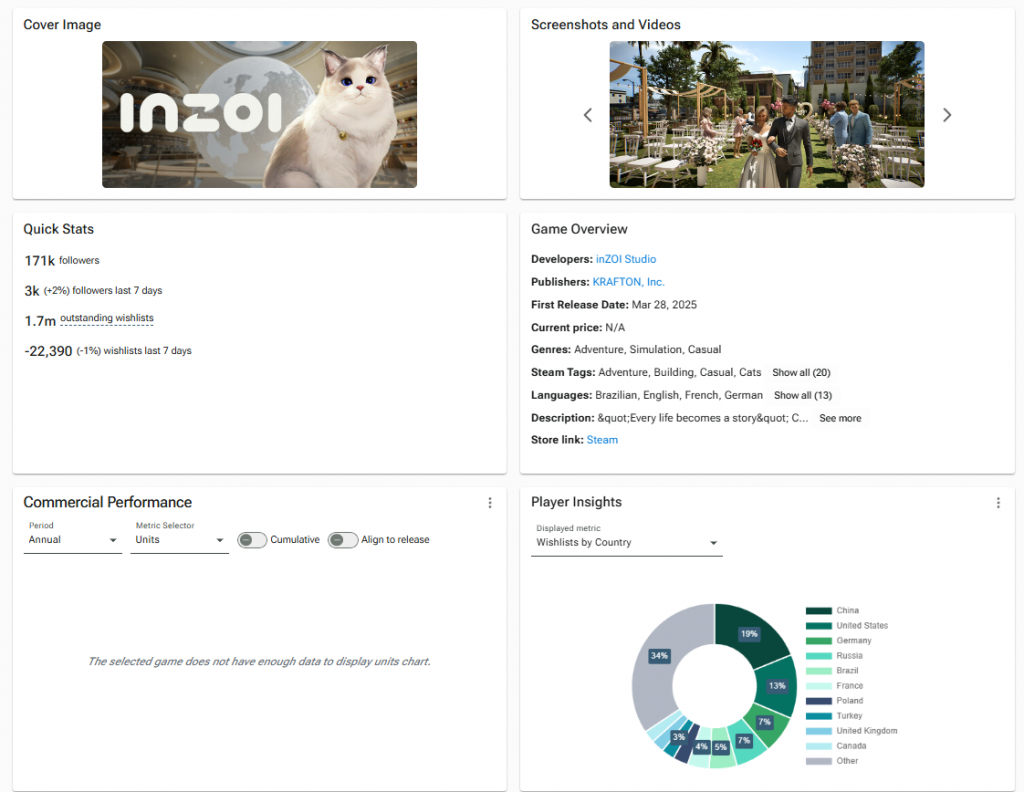
We are now showing wishlist breakdown by country estimate for unreleased (and also released) games! You can now see where the interest towards a game is coming from.

We are now showing wishlist breakdown by country estimate for unreleased (and also released) games! You can now see where the interest towards a game is coming from.
We have added a couple of much requested features to the paltform recently:
We’ve added 2 new columns to the Games Database – Month 1 and Year 1 unit sales. This allows you to have quick like-for-like comparison for launch performances.
Not only that, you can use these together with our “wishlists at launch” metric to get a better understanding of the wishlist to launch conversion ratios for the games you care about.
https://app.sensortower.com/vgi/games-database
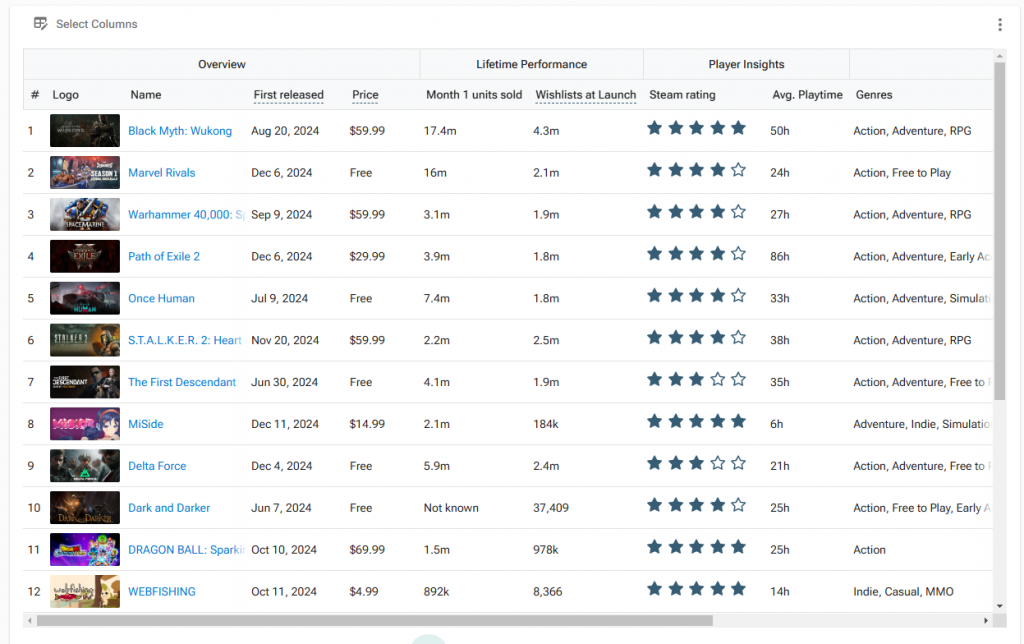
Top charts already had an option to see top CCU games. Our new DAU and MAU options add more colour to player engagement.
https://app.sensortower.com/vgi/top-charts
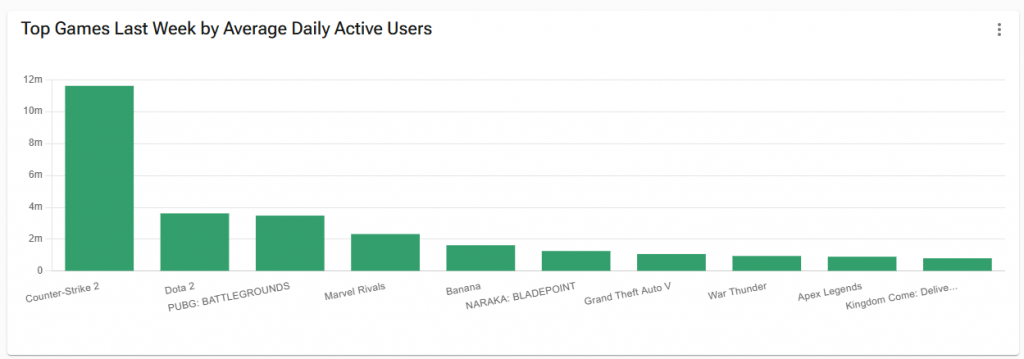
You will be now able to see when the actual Steam Store page was created for majority of games, including how long it took them to get from Store page creation to launch.
This is a super useful metric for understanding how to optimize the Steam page and how early other games release their Steam pages pre launch.
https://app.sensortower.com/vgi/game/kingdom-come-deliverance-ii

We’ll be bringing you more new features shortly! Stay tuned.
Video game engines have evolved significantly over the past decade. While mobile game development has long been dominated by third-party engines—most notably Unity—the same was not true for PC and console games.
Until recently, the majority of large titles were developed using in-house, custom-built engines. Not anymore.
– State of game engines today
– Game engine market share trends over time
– Forecasting the future trends
– Did Unity’s pricing debacle impact market share?
– The growth of Unreal Engine
– Is Godot really winning share?
– Game engine shares by sub-genre of games
Download the free PDF instantly without any email sign-up required: The Big Game Engines Report of 2025
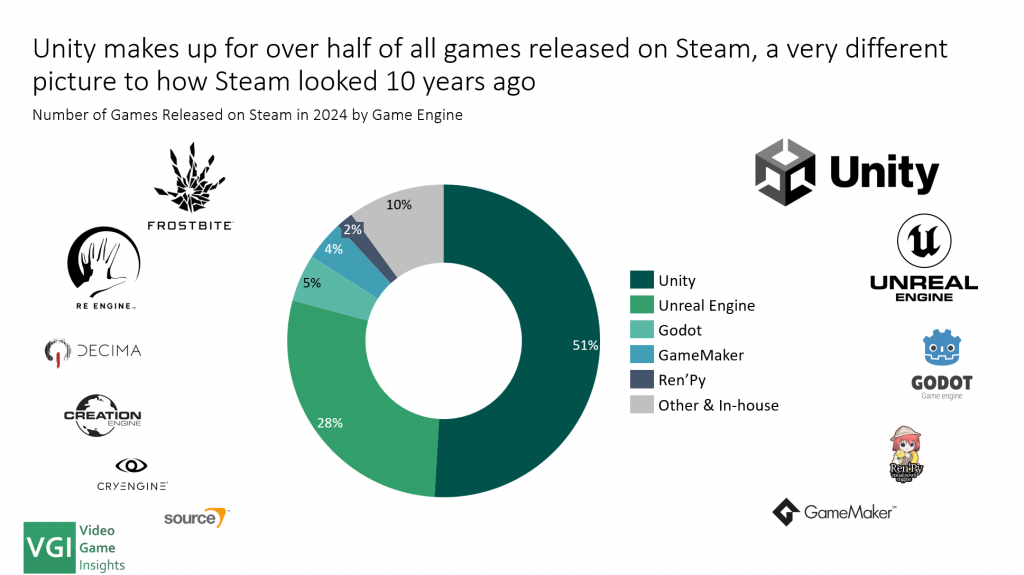
Download the free PDF instantly without any email sign-up required: The Big Game Engines Report of 2025
Video Game Insights provides a comprehensive data and intelligence platform for developers, publishers and investors.
Use the menu on the left to explore our tools or search for any game or games company in the search bar above.
Reach out to us at support@sensortower.com to learn more about the platform and get a product demo!
We have just added game engines as a datapoint to all games. As a business subscriber, you’ll be able to see the game engines for most games with >10k sales.
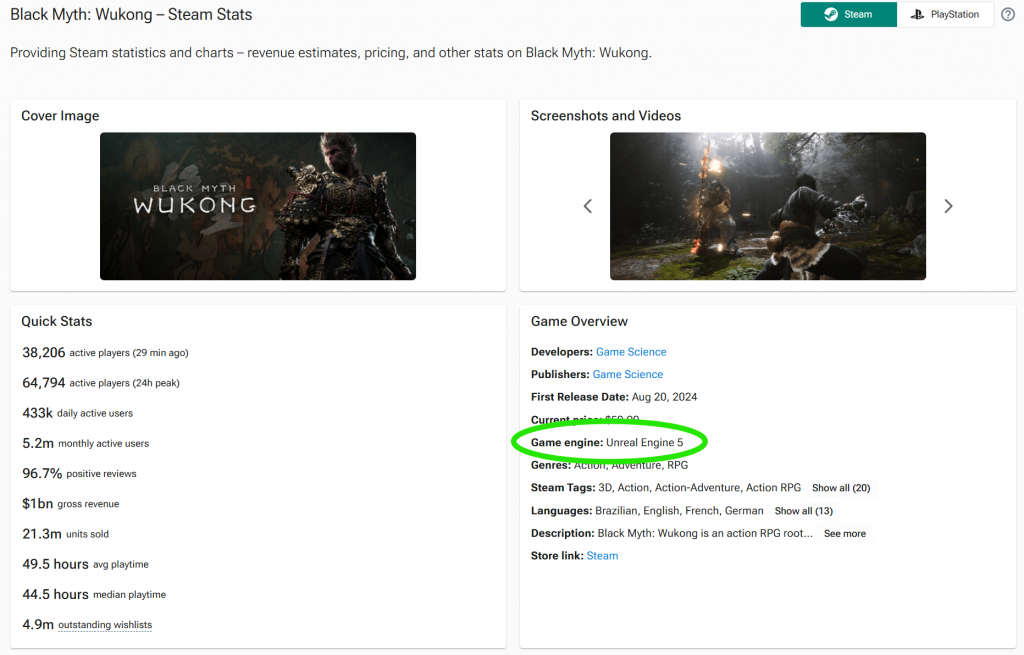
Business subscribers will also be able to see game engines as a separate column in the Games Database.
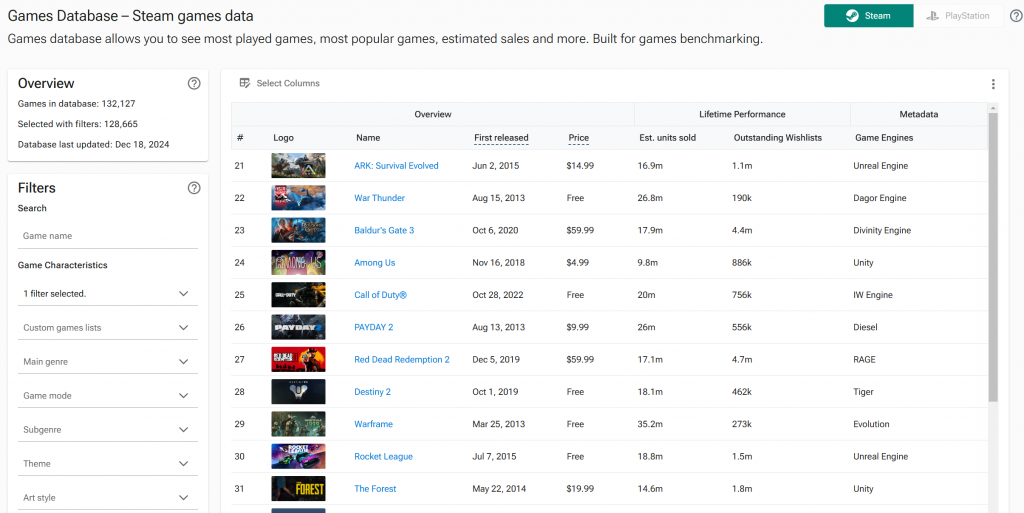
You’ll also be able to filter games based on the engines!
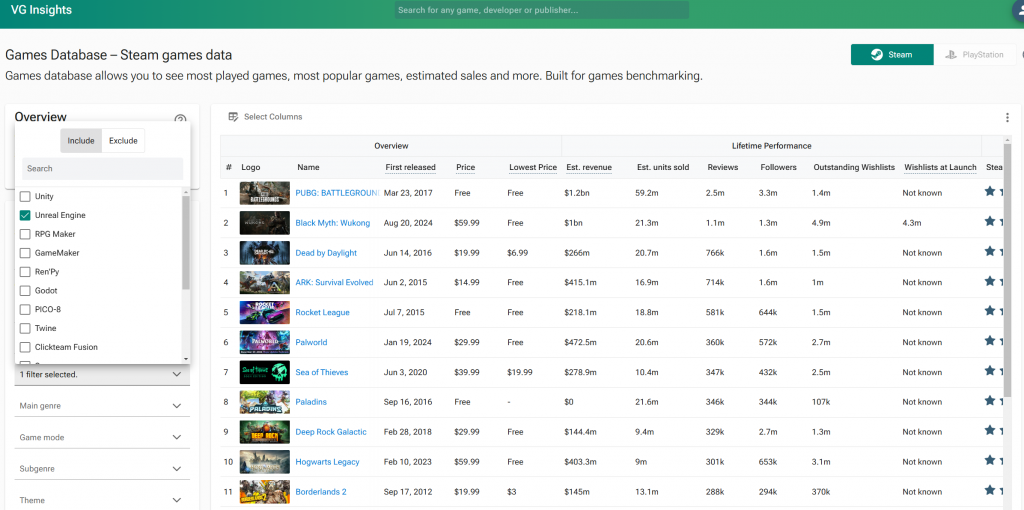
Our wishlist estimates have been the best in class since we launched them back in March. Well, they’ve just got a bit better. We have had to tweak our methodology slightly and this has resulted in even smaller variance VS actual numbers in our internal checks.
Key changes:
This impacts all wishlist numbers we show. We encourage you to update any analysis that relied on the old numbers.
Note that we try and keep any large scale estimation changes to a minimum, but in order to provide you with the best estimates possible, we do occasionally need to make these changes.
We will make sure to give a heads up in the future rather than report any changes retroactively.
The global indie games market has hit new heights in 2024. Our Global Indie Games Market Report 2024 offers an in-depth analysis of the indie game landscape. Discover key data on market growth, top-performing games, and trends shaping the future of indie gaming.
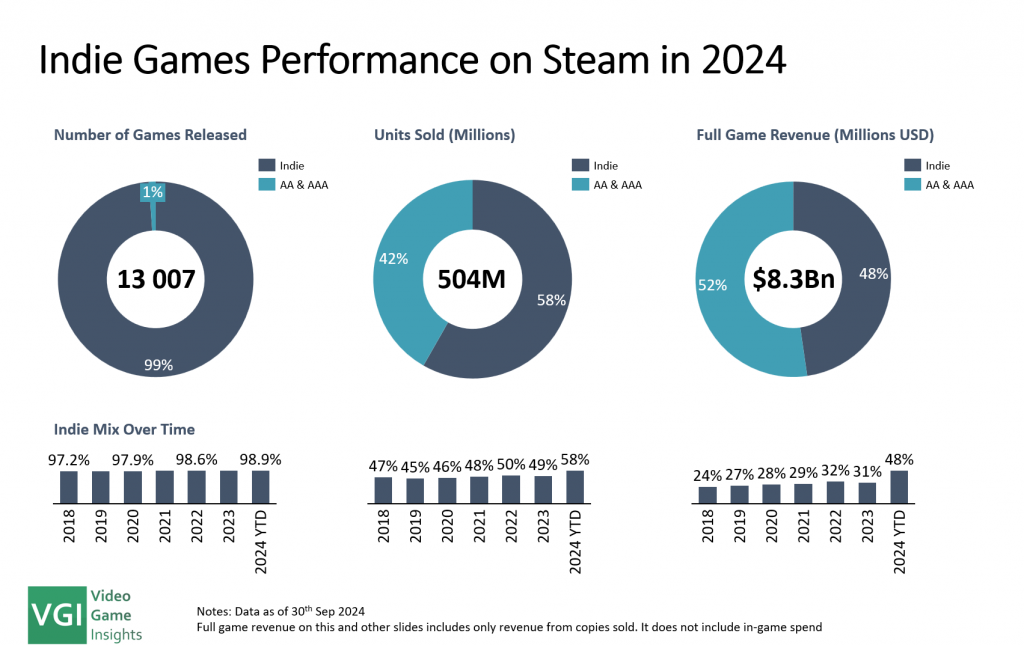
Download the free PDF instantly without any email sign-up required: VGI Global Indie Games Market Report 2024
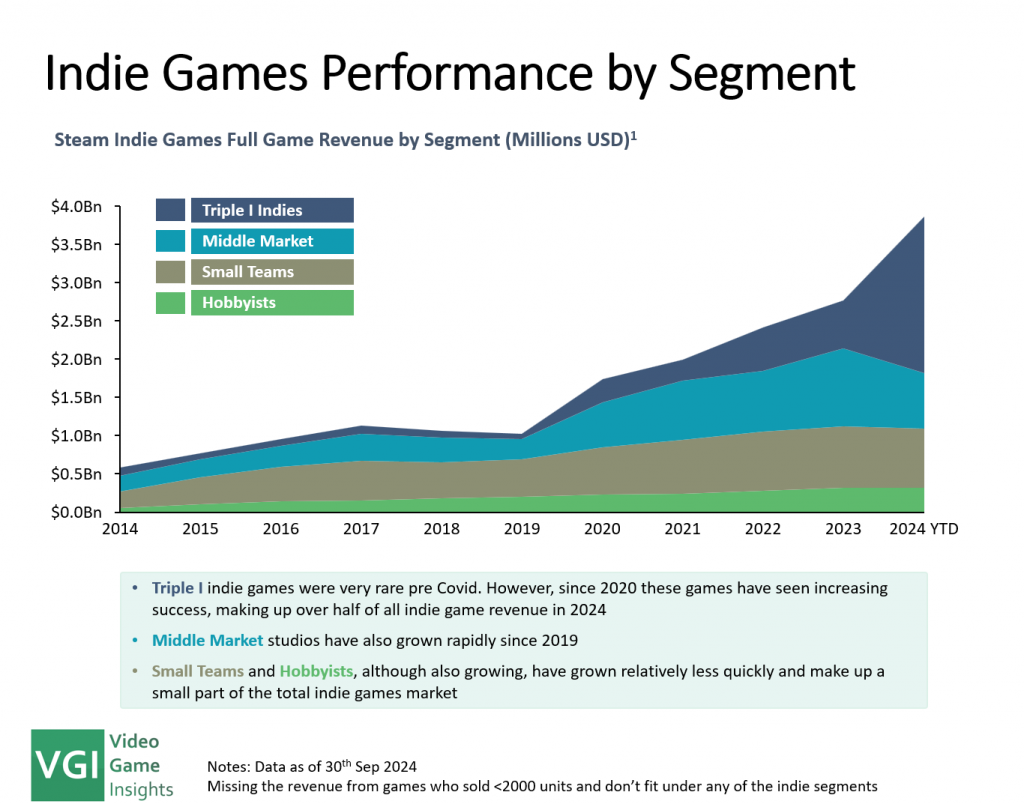
Download the free PDF instantly without any email sign-up required: VGI Global Indie Games Market Report 2024
Video Game Insights provides a comprehensive data and intelligence platform for developers, publishers and investors.
Use the menu on the left to explore our tools or search for any game or games company in the search bar above.
Reach out to us at support@sensortower.com to learn more about the platform and get a product demo!
We’ve just released our estimates for daily active users (DAU) and weekly active users (WAU) for Steam games.
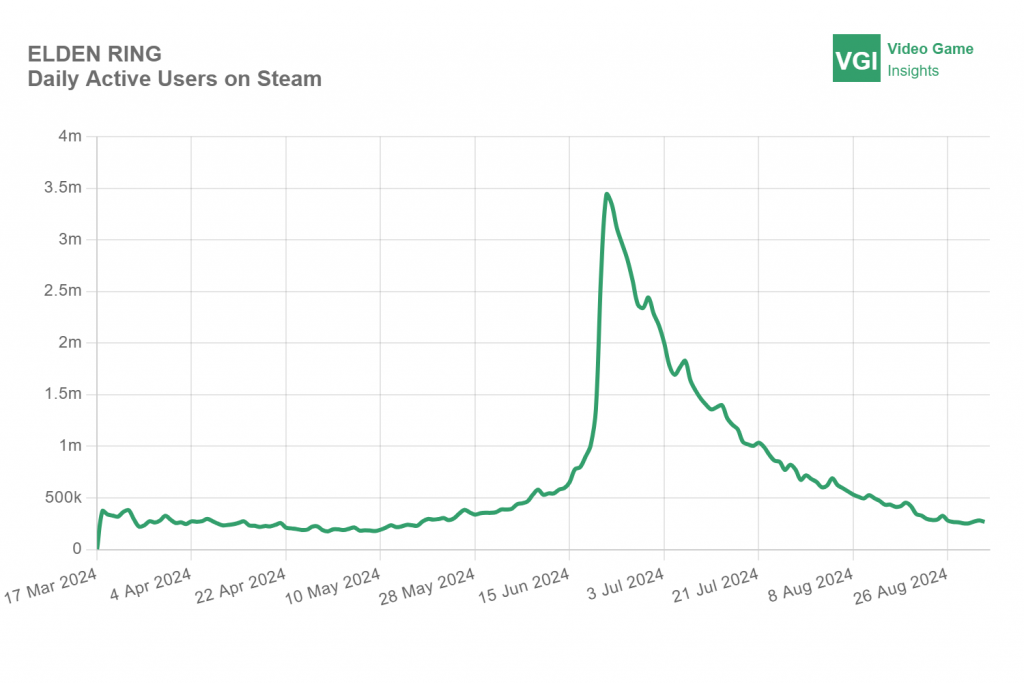
You’ll be able to see these metrics for any game with at least 100k units sold by going on their individual games page and using the “historical data” section.
Note that these metrics do tend to give a highly correlated view to the much used concurrent users (CCU) metric on Steam. However, DAU and WAU are much more used in corporate environments and serve as a more practical input for most modelling purposes.
Additionally, the DAU metric sets us up for the upcoming PlayStation data where you will be able to start comparing PC & PS DAU metrics and see what the platform mix looks like for multi-platform games.
We have revamped our filter system, making it easier to use and improving its functionality.
Filters are available on many pages, from Steam Analytics to Games Database and can help you narrow down a list of games or companies to look at. We’ve long had an extensive list of filters to choose from, but we’ve now made it even more powerful to use.
You can now include as well as exclude characteristics in filters. For example, you might want to see all 4x games, but exclude any turn-based games, leaving only real time 4x games in the list.
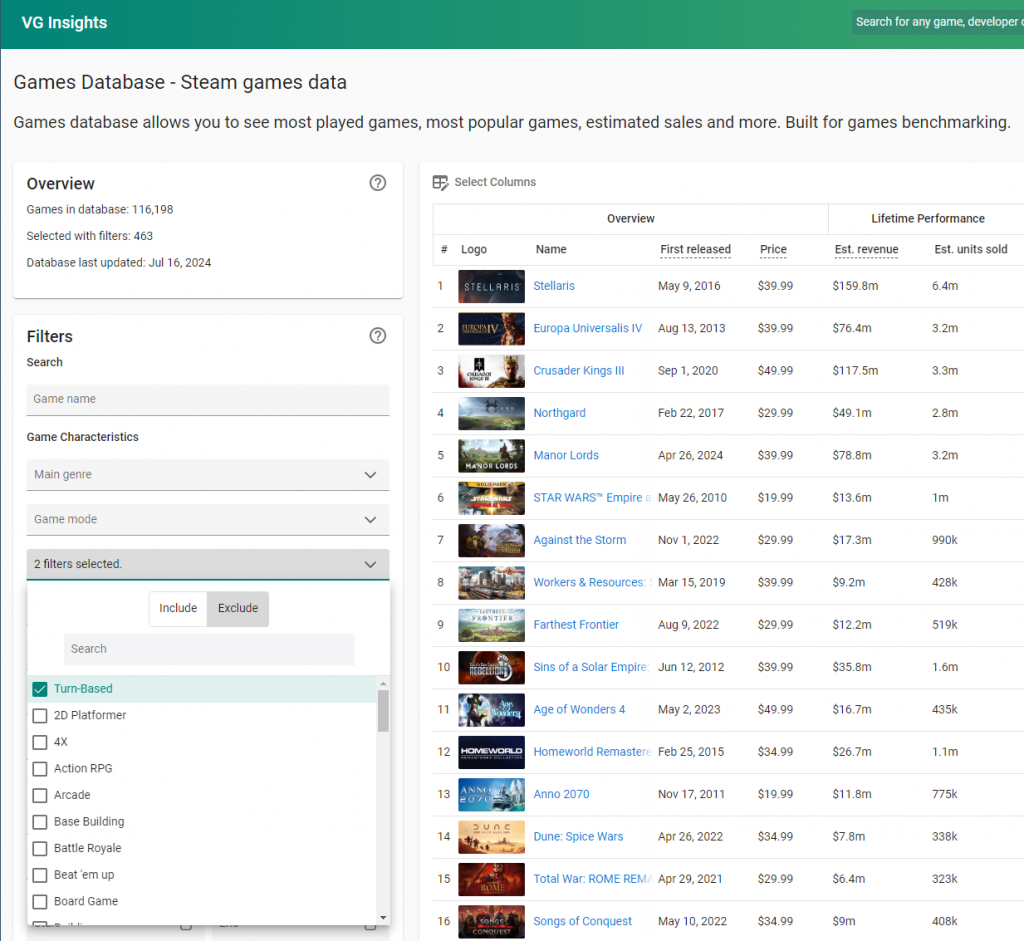
Some of our filters had tens if not hundreds of options to choose from. We have now added a search bar to make it easier to look for the particular item you’re interested in. For example, you can now find all the RPG tags with ease.

2023 saw almost 800 co-op games released on Steam, over double from five years ago.

The core principle for cooperative games is that a small group of players can work together as a team. Covid saw a peak in co-op game interest as catching up in the real world was swapped for social gaming sessions. This report explores how the co-op game popularity has trended since.
Co-op games tend to have an organic player acquisition flywheel where players persuade their friends to get the game. Therefore, co-op games tend to outperform other types of games in their performance. These organic hype cycles have become especially evident with the launches of Palworld and Helldivers 2 this year. The report looks into just how much audience attention share these games grabbed.
Download the free PDF instantly without any email sign-up required: Rise of the Co-Op Games
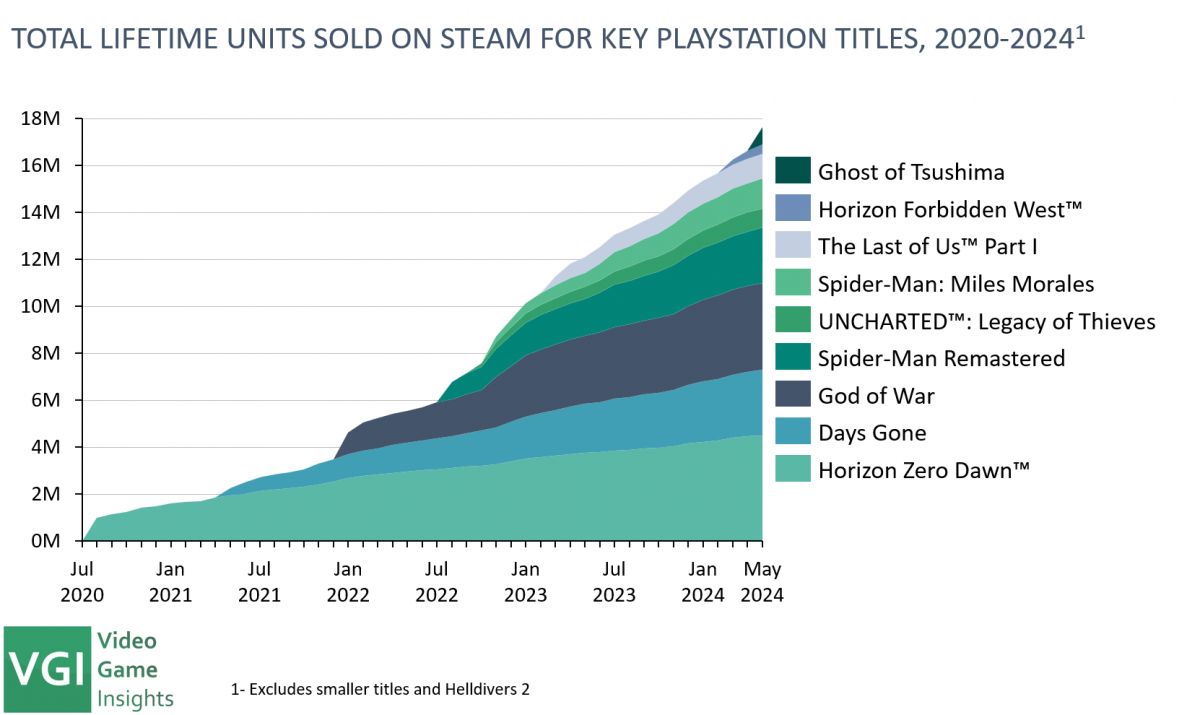
For many years, PlayStation has relied on platform exclusives to encourage players to buy its hardware and remain within its ecosystem. This strategy, also commonly used by Xbox and Nintendo, has been highly effective. However, since 2020, there has been a significant shift in this approach. This article explores why publishers are moving towards cross-platform strategies and examines how this shift has impacted PlayStation to date.
Up until 2020, PlayStation had released only three games on Steam. Their first ever game, funnily enough, was Helldivers. These initial releases were relatively minor in the grand scheme of Sony’s portfolio.
However, in August 2020, Horizon Zero Dawn was launched on Steam, marking the beginning of a significant shift. Since then, 14 PlayStation exclusives have made their way to the Steam platform.
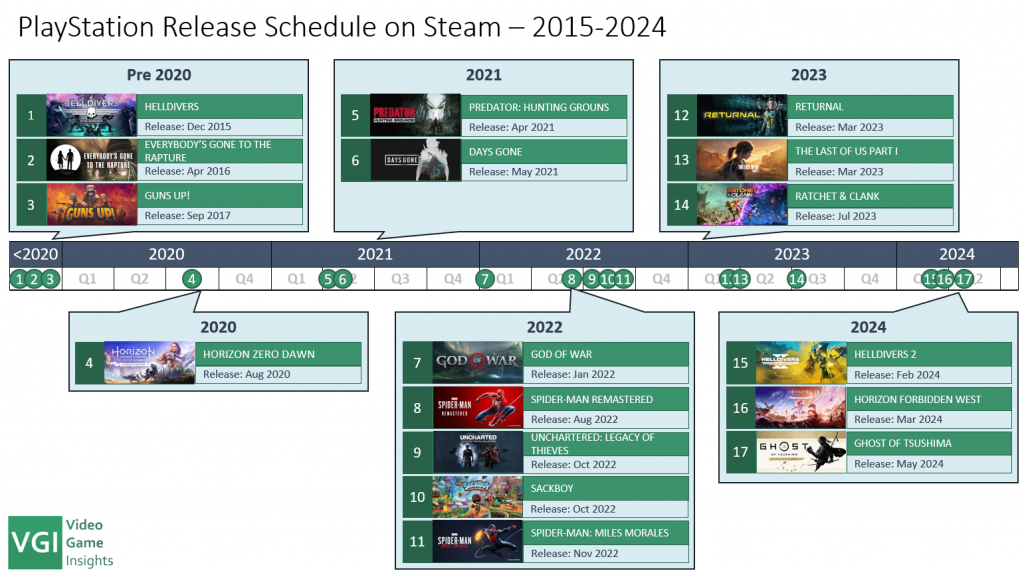
The release strategy for these games can be categorized into three distinct approaches:
In total, these PlayStation ports have sold over 17 million units on PC, excluding Helldivers 2. Including Helldivers 2, the total exceeds 28 million units (yes, Helldivers 2 is that crazy).
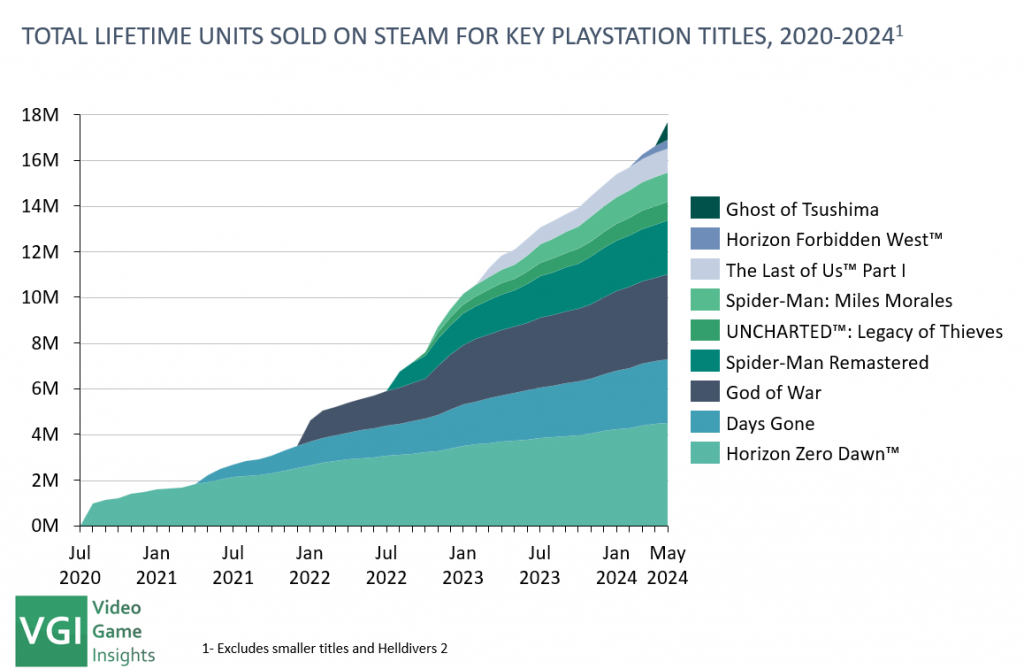
All unit sales estimates are derived from the Video Game Insights platform data. Although these figures are estimates, they align closely with PlayStation’s reported and leaked numbers, providing a fairly reliable approximation of actual sales.
It’s a careful balancing act to get the porting timing just right, but there are clear advantages VS a full exclusivity approach.
Ghost of Tsushima is the most recent example of PlayStation’s strategy, launching on Steam in May 2024, nearly four years after its original release. Its Steam debut was one of the most successful ports to date, with over 800,000 units sold in the first 20 days, comparable to the launches of Spider-Man and Horizon Zero Dawn.
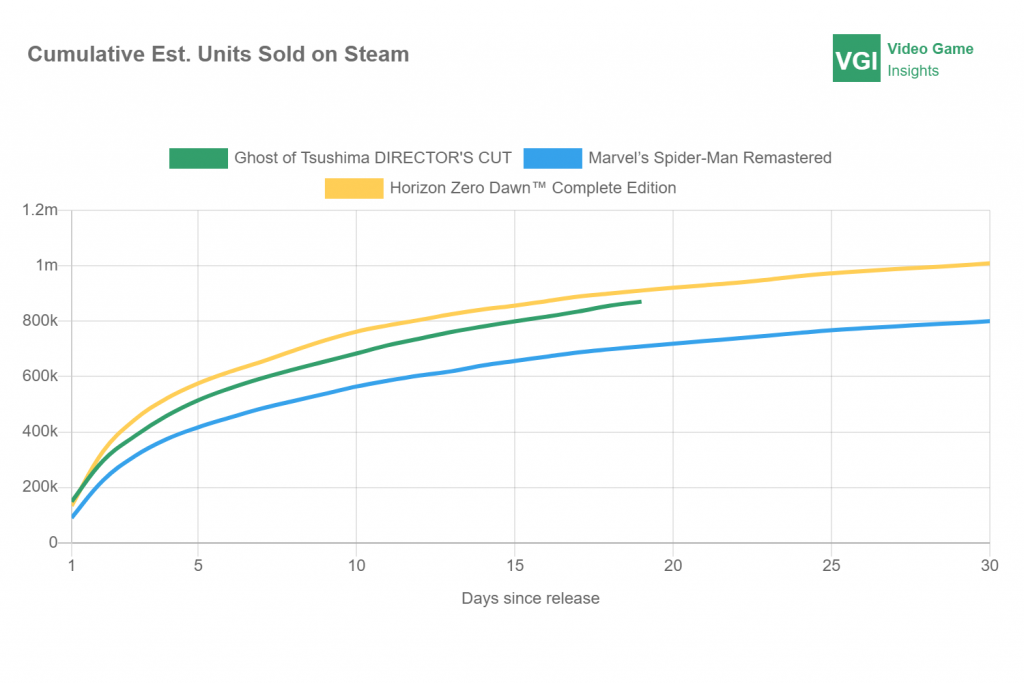
In terms of player retention, Ghost of Tsushima has performed even better. While it launched with similar concurrent player (CCU) numbers as Spider-Man and Horizon, it has maintained nearly double the CCU by day 20.
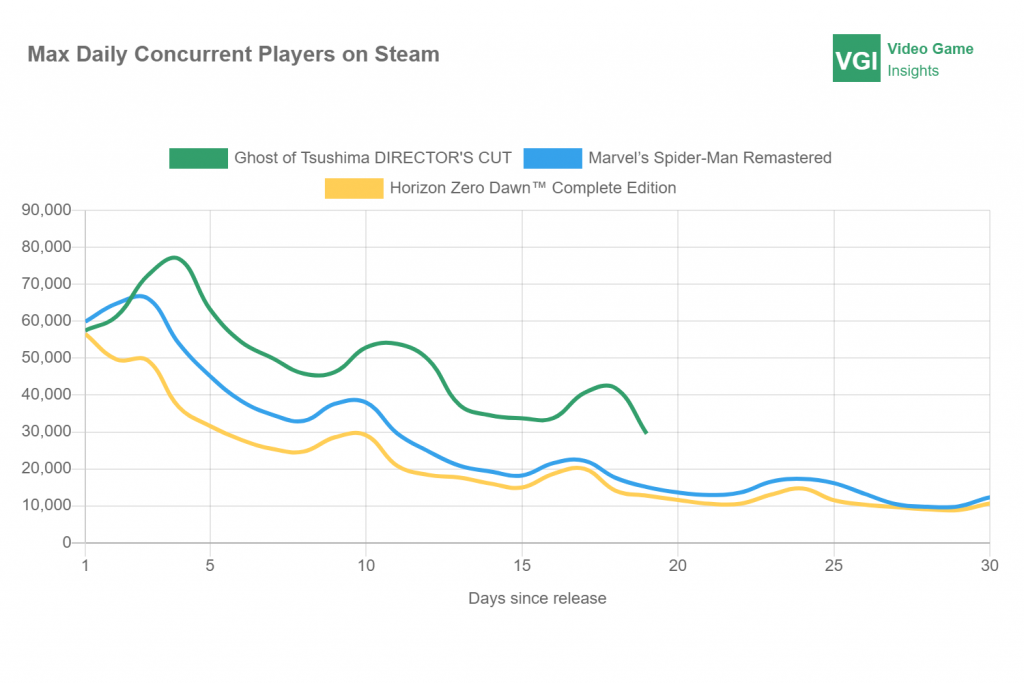
While Ghost of Tsushima is a great title and well received (90% positive ratings on Steam), it’s an objectively less known IP VS Spider-man and Horizon. Ghost of Tsushima sold well on PlayStation but didn’t get close to the other two. So, what made its launch so successful on Steam?
This success highlights the effectiveness of PlayStation’s Steam strategy. Ghost of Tsushima built up nearly 1.5 million wishlists within a couple of months before its launch, indicating growing trust and anticipation for PlayStation ports.
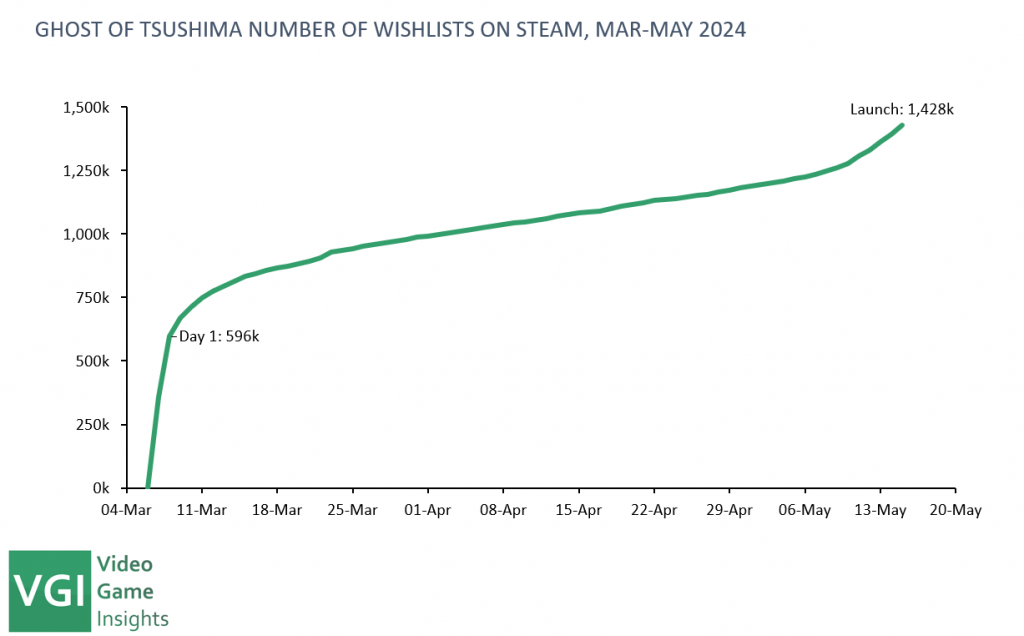
This can be seen quite clearly when looking at the Ghost of Tsushima player overlap
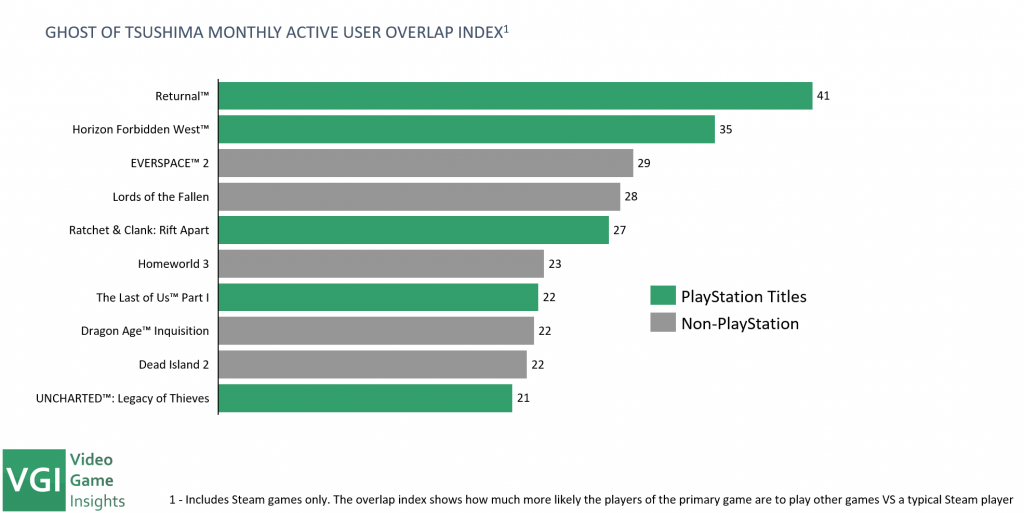
In fact, 5 of the 10 highest overlap indexed games for Ghost of Tsushima are PlayStation titles.
The Player Overlap Index shows how much more likely players of Ghost of Tsushima are to play other games VS your typical Steam player. You can read more about the Player Overlap Index here.
That’s a tricky question. It depends. PlayStation PC titles have generated an estimated $830 million over the last 4 years.
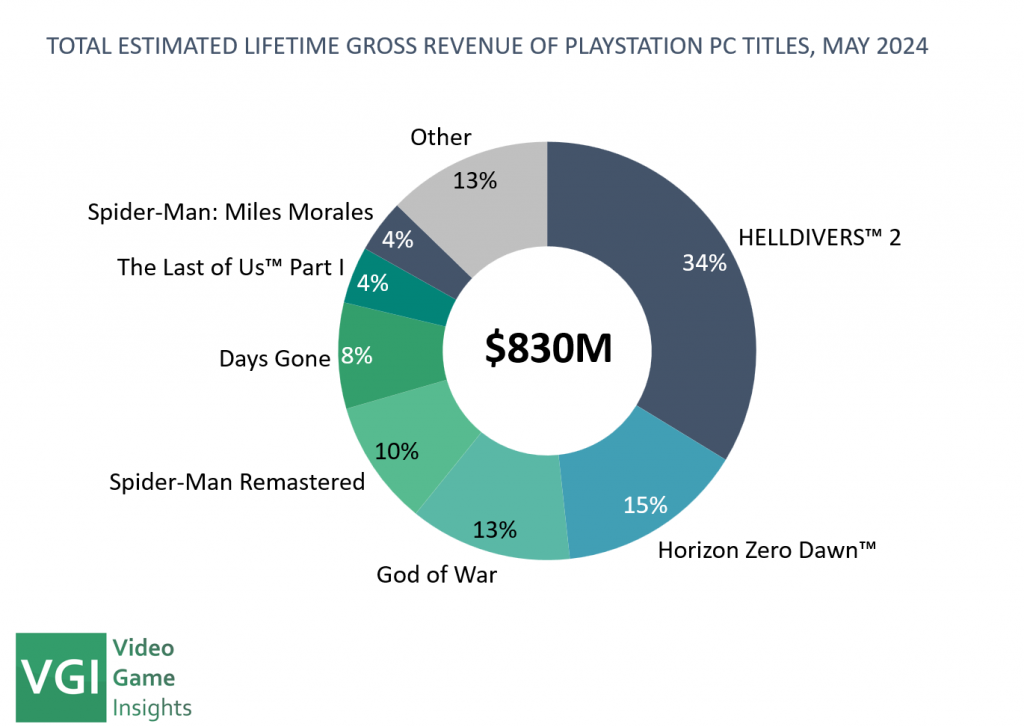
While impressive, this amount pales in comparison to the $29.4 billion generated by Sony’s Game & Network Services segment in FY23 alone. Of course, the G&NS revenue includes first party game sales, physical console sales, PlayStation + subscriptions, and importantly, the 30% cut they take from all sales on PlayStation Store. Still, it’s fair to say that the PC revenues on their own will never be a major segment for Sony’s gaming division.
For a fairer comparison, let’s examine PC sales relative to PlayStation platform sales using Horizon Zero Dawn as an example. Horizon Zero Dawn has sold about 24M units across PlayStation and PC by May 2023. 3.7M of that or c. 15% of total units sold were on PC. However, the PC pricing has been higher (even after Steam cut), given Horizon has been priced at $19.99 on PlayStation for the last 6 years.
We estimate that Horizon Zero Dawn has made approximately $120M on PC to date and around $500M on PlayStation. Therefore, releasing Horizon on PC has resulted in a roughly 25% revenue increase, a substantial boost for minimal effort.
With an estimated development budget of $47M (incredibly low for a AAA game of this quality) it means that the PC port alone has paid for the development of the entire game many times over.
If Reddit is to be believed (and it almost never is), no PC player would ever betray their so-called “master race” and they would never do such an embarrassing thing as to move to PS5. And the truth is, there is a group of hard-core PC players who never will. But this group is getting proportionally smaller. Steam is not a niche platform anymore. There are now over 35 million people active on Steam at any given time, nearly double the pre-COVID numbers.
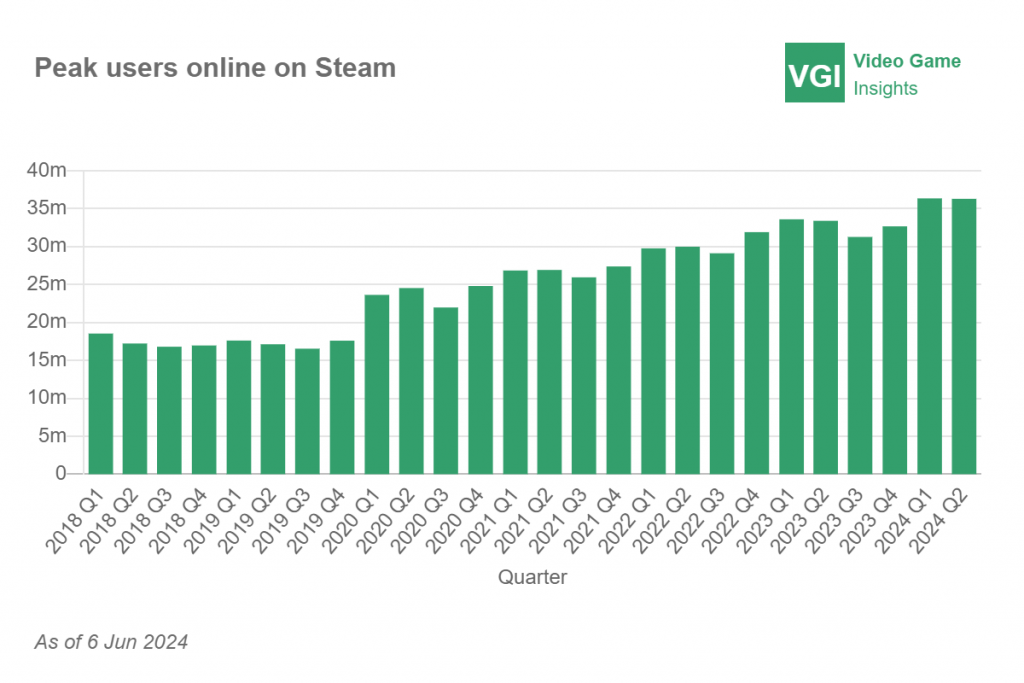
The majority of these players are not hard-core gamers and die-hard PC fans anymore. The casual and mid-core player mix is growing and that’s exactly the audience that Sony can attract. As the PC player base grows and diversifies, the “PC players don’t care for story-based single-player games” will hold less true. Having these games on PC can arguably also serve an “educational” purpose. How can you learn to love these experiences if you never get to try them?
Other publishers have noticed PlayStation’s success and are announcing similar plans to adopt “multi-platform strategies.” Most recently, Square Enix revealed that they are “aggressively pursuing a multiplatform strategy.” While Xbox games have been available on PC for some time, they are now experimenting with bringing some titles to PlayStation.
In a period of slower industry growth, companies are breaking down barriers in search of new opportunities beyond their existing ecosystems. Gamers benefit from a broader access to high-quality titles, while publishers enjoy increased revenue streams and a larger, more engaged audience.